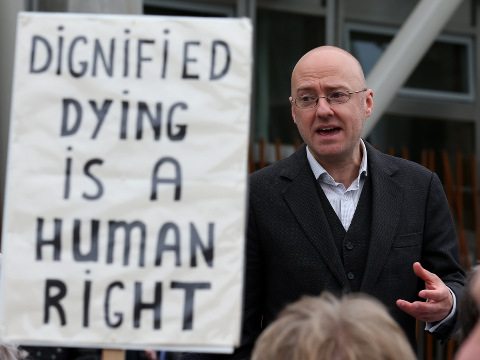The practice of mercy killings has been a prevalent norm throughout the course of human history. However, in recent times, we have seen a spark in the moral debate relating to this issue. Case 6.3 highlights the rift in beliefs relating to euthanasia. There are 3 recognized forms of euthanasia: voluntary, non-voluntary, and involuntary (BBC 2014). Voluntary euthanasia is performed with the explicit consent of the person wishing to end their life. Non-voluntary euthanasia occurs when someone is unable to give consent. Involuntary euthanasia concerns cases where someone wants to live but is killed regardless. For instance, “A soldier has their stomach blown open by a shell burst. They are in great pain and screaming in agony. They beg the army doctor to save their life. The doctor knows that they will die in ten minutes whatever happens. As he has no painkilling drugs with him he decides to spare the soldier further pain and shoots them dead.” (BBC 2014) The morality of these cases is usually taken on an individual case basis, and the ethical concerns are raised based on distinct opinions.
Case 6.3 in Well and Good describes the circumstances of Robert Latimer, who murdered his 12- year old daughter in 1993. Robert’s daughter Tracy suffered from numerous and intense disabilities, leading to incredible pain and torment. Not wanting to watch his daughter suffer any longer without the prospect of a cure or helpful treatment, Robert decided to end her life by exposing her to carbon monoxide. This case concerns the enactment of non-voluntary euthanasia through what could be considered a “mercy killing”. Robert’s daughter died a peaceful death, juxtaposing her tempestuous life. Another ethical issue comes to play with the concept of autonomy. Tracy could not voice her opinion because of her mental disability. Therefore, this case brings forth the question: is it morally justified to peacefully end someone’s life without their consent?
The ethical concerns with euthanasia arise from the Hippocratic oath. Physicians are not meant to harm patients and should not intentionally lead them towards death. However, what if death is in the best interest of the patient? For instance, almost 5,000 cases of euthanasia performed in the Netherlands in 1991 lacked patient consent. This contrasts many views held in the United States regarding assisted suicide. Some argue that assisted suicide is a sympathetic way to allow patients to die with dignity, others deem it as unacceptable as murder in the first degree. In the case of Tracy Latimer, could it be argued that her life was filled with more pain than happiness? Thus, her death was a merciful escape from further misery. Or was her death unwarranted? I believe Tracy’s father chose to end her suffering with good intentions, regardless of the circumstances which he went about it. I do not believe his actions were malicious in nature or he meant to cause Tracy any harm. It is more difficult to say whether he should have killed her, but his actions speak to the desperation he must have felt watching his daughter live with constant pain.
When reading about the morality of euthanasia, certain ideas are frequently shared, like the comparison between the legality of non-voluntary euthanasia, abortion, and the withdrawal of life support. These situations will most certainly involve the death of someone who would be unable to consent. For example, in the United States, it is perfectly legal to abort a child due to the development of a disability in-utero. Moreover, it is not only legal but incredibly common to terminate life supporting technology for patients in long-term comas. Many consider these humane choices; a life is ended to prevent future suffering and discomfort. After reading about this topic, I hold the belief that euthanasia is beneficial to patients who would otherwise be in distress, including those with severe mental incapacities. I would love to hear other points of views in the comments. Are Robert’s actions any different to terminating the life support for a comatose patient? How can we compare these distinct circumstances?
Other example of a euthanasia case:
https://www.youtube.com/watch?v=MAHey2LjA6c
References:
“Background about Euthanasia in The Netherlands.” Patients Rights Council. N.p., 2013. Web. 17 Feb. 2017.
“BBC – Ethics – Euthanasia: Voluntary and Involuntary Euthanasia.” BBC News. BBC, 2014. Web. 17 Feb. 2017.
Cook, Michael. “Why Not Non-voluntary Euthanasia for Psychiatric Patients?” BioEdge. N.p., 17 Oct. 2015. Web. 17 Feb. 2017.
Manninen, B. A. “A Case for Justified Non‐voluntary Active Euthanasia: Exploring the Ethics of the Groningen Protocol.” Journal of Medical Ethics. BMJ Group, Nov. 2006. Web. 17 Feb. 2017.
Thomas, John E., Wilfrid J. Waluchow, and Elisabeth Gedge. Well and Good: A Case Study Approach to Health Care Ethics. Peterborough, Ontario: Broadview, 2014. Print.


Hello Gisell.
This is a very well written post and I appreciate your use of the video to give other examples of euthanasia. You bring up very good points to consider. I believe that at first glance, it may seem horrible to read that a father ended the life of his daughter. It is difficult to think about; however, considering her special circumstances, I began to understand his actions and I do not believe that his sentencing should be as severe. I do not believe that no punishment should be issued, but because of these special circumstances and his intentions, he should receive alternate sentencing such as therapy. I think that euthanasia is such a controversial topic because of the idea of death in society. We often view death as the worst alternative because life is so precious. However, many people, such as Tracy, undergo so much suffering and their quality of life is so dull that they are not living at all. I believe that euthanasia should be a viable option in a professional setting rather than simply being carried out at home by a loved one.
Hi Gisell and Kiana,
Thank you both for insightful posts and comments, respectively. I understand where each of you are coming from when considering Mr. Latimer’s actions and the repercussions he faces as a result, and believe that all aspects of the case should be considered when making rulings in this light. I do think, however, that the precedent set by this ruling must be considered before it is made. If the court agrees to lessen the sentence on the basis of good intentions, there is a precedent set that may justify lighter sentences for similar crimes in the future. I’m not quite sure yet on my opinion of the court’s ruling in this particular instance, but believe that the future impact of this case should be considered in its ruling as well. Do you think the influence of a potential precedence should influence the decision?
Thanks!
Elisabeth Crusey
Hi Gisell,
I agree with your overall feelings regarding the actions of Tracy’s father and I think that it is very important to distinguish the different types of euthanasia. Euthanasia and “mercy killings” are very controversial; especially in cases such as these where the individual whose life was taken was unable to consent/ verbalize her opinion on the matter. Non-voluntary euthanasia I believe to be the type of euthanasia to fall most in a slippery slope category. In the case of voluntary euthanasia, the individual is able to knowingly consent and in the case of involuntary euthanasia, the individual most likely would soon reach death whether or not they were euthanized. However, in the case of “mercy killings”, it is unclear what the individual actually wants and therefore the decision is left to speculation.
In Tracy’s case, her dad deemed that her pain was simply too much for her to sustain and decided to take matters into his own hands. While I sympathize with his decision, I am conflicted on what consequences should follow for Robert. The accounts given by his family, Tracy’s doctor and Judge Noble indicated that he was a compassionate man who loved his daughter, providing evidence that his decision to take Tracy’s life was not malicious. However, did he have the right to make that decision? With autonomy in mind, we know that Tracy was incompetent in terms of making this decision due to her mental disabilities, so someone else does in fact need to make her decisions for her. Does whether or not the role of surrogate decision maker falls on her parents, doctor or a judge depend on the intentions of all parties involved? Some may argue that Robert should not assume the role of surrogate decision maker in this case; however if he had decided to go through with the surgery would he then be recognized as a surrogate decision maker? I am also curious how opinions on the matter would shift if the physician were the surrogate decision maker. Is there ever a case in which the physician can authorize or enforce a non-voluntary euthanasia? Would this act go against their duties as a physician to do no harm, or would putting a patient out of their misery be a duty of beneficence?
I really enjoyed this post! Euthanasia is definitely a very controversial topic that is seen in our society today in a variety of forms. Do you think it is possible for there to be a level of consistency in terms of the consequences/ subsequent actions taken following a case of euthanasia? I think this would help alleviate some of the controversy surrounding the topic; however when it comes to “mercy killings” I do not know if there can ever be a strict response due to the amount of variability in each case. Let me know what you think!
Hi Gisell,
I really appreciated this post, and think that you have a really interesting perspective. You really highlighted the issue concerning surrogate consent–an individual must act on behalf of the patient without fully knowing their overall quality of life and wishes. In this particular case, it was evident that Latimer’s daughter was suffering, which is why the father justified ending her life. Essentially, Robert believed that he was acting on his daughter’s best interest.
I think that the issue with surrogate consent here is highly problematic. Generally, competent patients with a terminal illness/low quality of life can rightfully seek assisted suicide. But is this even possible in the case of surrogate consent? In other words, do surrogates have the same authority to seek assisted suicide on someone’s behalf?